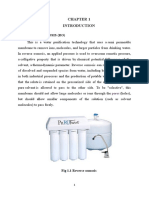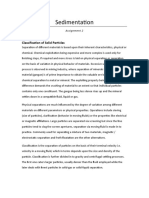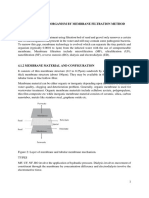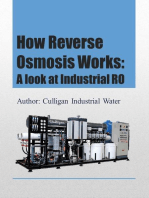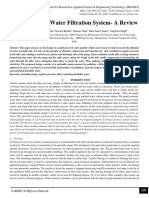Advance Treatt
Advance Treatt
Uploaded by
winkiCopyright:
Available Formats
Advance Treatt
Advance Treatt
Uploaded by
winkiOriginal Title
Copyright
Available Formats
Share this document
Did you find this document useful?
Is this content inappropriate?
Copyright:
Available Formats
Advance Treatt
Advance Treatt
Uploaded by
winkiCopyright:
Available Formats
TOPIC:
Advanced Waste Water Treatment
Name: Venkateswara reddy
M.TECH CHEMICAL
REG NO: 1612012010005
1 st yr
TABLE OF CONTENTS:
1. Abstract ............................................................................................02
2. Introduction........................................................................................02
3. Various advance techiniques.................................................................02
4. Various methods.................................................................................03
5 .Conclusion ........................................................................................10
6 References.........................................................................................10
1 | Page
TOPIC:
Advanced Waste Water Treatment
1) Abstract :
This report is about understanding the treatment of waste water using
advance techniques or methods.
2) Introduction
Waste water arrives from various plant and the effluent from a typical
treatment plant still contains 20-40 mg/L BOD which may be objectionable in
some streams. Suspended solids, in addition to contributing to BOD, may settle
on the stream bed and inhibit certain forms of aquatic life.
The BOD if discharged into a stream with low flow, can cause damage to
aquatic life by reducing the dissolved oxygen content. In addition the
secondary effluent contains significant amounts of plant nutrients and dissolved
solids. If the waste water is of industrial origin, it may also contain traces of
organic chemicals, heavy metals and other contaminants.
3) Various Advance techniques
Various advance techniques used to treat waste water are as follows
1. Suspended Solids
2. BOD
3. Plant nutrients
4. Dissolved solids
5. Toxic substances
These methods may be introduced at any stage of the total treatment process
as in the case of industrial waterways or may be used for complete removal of
pollutants after secondary treatment.
4) Various Methods
2 | Page
TOPIC:
Advanced Waste Water Treatment
1. Removal of suspended solids:
This treatment implies the removal of those materials that have been
carried over from a secondary treatment settler. Many methods were proposed
of which two methods were commonly used.
The two methods are micro staining and chemical coagulation
followed by settling and mixed media filtration:
Micro staining:
It is a special type of filtration process which makes use of filters oven from
stainless steel wires with very fine pores of 60-70 microns size. This filter helps
to remove very fine particles. High flow rates and low back pressures are
achieved
Coagulation and flocculation:
The object of coagulation is to alter these particles in such a way as to allow
them to adhere to each other. Most colloids of interest in water treatment
remain suspended in solution because they have a net negative surface charge
that causes the particles to repel each other. The intended action of the
coagulant is to neutralize that charge, allowing the particles to come together
to form larger particles that can be more easily removed from the raw water.
The usual coagulant is alum [AI2(S04)2 18H20], though FeCI3, FeS04 and
other coagulants, such as polyelectrolytes, can be used. Alum when added to
water, the aluminum in this salt hydrolyses by reactions that consume alkalinity
in the water such as:
Al (HO)6] + 3 3HC03 AI(OH)3(s) + 3Co2 + 6H2o .. (1)
The gelatinous hydroxide thus formed carries suspended material with it as it
settles. Metal ions in coagulants also react with virus proteins and destroy up to
99% of the virus in water. Anhydrous ion (III) sulphate can also act as effective
coagulant similar to aluminum sulfate. An advantage with iron (III) sulfate it
that it works over a wide range of pH.
Filtration:
3 | Page
TOPIC:
Advanced Waste Water Treatment
If properly formed, the addition of chemicals for promoting coagulation and
flocculation can remove both suspended and colloidal solids. After the floes are
formed, the solution is led to a settling tank where the floes are allowed to
settle.
While most of the flocculated material is removed in the settling tank, some
floe do not settle. These floes are removed by the filtration process, which is
usually carried out using beds of porous media such as sand or coal. The
current trend is to use a mixed media filter which consists of fine garnet in
the bottom layer, silica sand in the middle layer and coarse coal in the top layer
which reduces clogging.
Ultra-Filtration:
a. Selectively filters only molecules of a specified size and weight.
b. Removes e.g. various viruses.
c. Used for sterilization, clarification, wastewater treatment.
d. Membrane size 1 _ 0.01 m. is used
This is a dynamic filtering process with a predominance of physical
(mechanical) phenomena in which chemical phenomena are also involved. The
membranes used, polymeric or mineral, allow dissolved salts to pass while they
reject high molecular weights selectively.
The selectivity depends on the membrane structure and is defined as the cutoff of molecular weight, which the membrane can separate with an efficiency of
90 % (although this definition may not be rigorous depending on the molecular
shape)
Commercial membranes applied in ultra-filtering can separate substances with
a molecular weight between 1.000 and 10.000. Ultra-filtering systems
generally work in a pressure range between 1.5 and 7 bar With industrial
discharge waters the fluxes of permeate generally fluctuate between 0.5 and 1
5 m3 / h / m2 surface, depending on the concentration of the substances to
be separated, with energy consumptions varying between 2 and 20 KWh per
m3 of permeate. The single pass ultra-filtering process is the simplest and
4 | Page
TOPIC:
Advanced Waste Water Treatment
most commonly used process for water treatment because it allows the
recovery of high percentages of permeate (approximately 90-95 %).
There has been a relatively recent application of this technique in the metal
finishing sector for the recovery of degreasing baths (the first cleaning bath in
metal-finishing processes, for pieces which are still dirty with lubricating
substances).
The solution to be treated is passed through the membrane at a certain speed
and under hydrostatic pressure, obtaining a concentrated fraction of oils and
grease for disposal, while the filtrate is recovered and reused to prepare new
baths.
Nano Filtration:
The nano filtration technique is mainly used for the removal of two valued ions
and the larger mono valued ions such as heavy metals. This technique can be
seen as a coarse RO (reversed osmosis) membrane. Because nano filtration
uses less fine membranes, the feed pressure of the NF system is generally
lower compared to RO systems. Also the fouling rate is lower compared to Ro
systems.
2. Removal of Dissolved Solids:
The dissolved solids are of both organic and inorganic types. A number of
methods have been investigated for the removal of inorganic constituents from
waste water.
Three methods which are finding wide application in advanced waste treatment
are ion-exchange, electro dialysis and reverse osmosis. For the removal of
soluble organics from waste water the most commonly used method is
adsorption on activated carbon. Solvent extraction is also used to recover
certain organic chemicals like phenol and amines from industrial waste waters.
Ion exchange:
This technique has been used extensively to remove hardness, and iron and
manganese salts in drinking water supplies. It has also been used selectively to
remove specific impurities and to recover valuable trace metals like chromium,
nickel, copper, lead and cadmium from industrial waste discharges. The process
5 | Page
TOPIC:
Advanced Waste Water Treatment
takes advantage of the ability of certain natural and synthetic materials to
exchange one of their ions.
A number of naturally occurring minerals have ion exchange properties. Among
them the notable ones are aluminum silicate minerals, which are called
zeolites. Synthetic zeolites have been prepared using solutions of sodium
silicate and sodium aluminate.
Alternatively synthetic ion-exchange resins composed of organic polymer with
attached functional groups such as (strongly acidic cation exchange resins), or
COO 3 -SO H+~ H+ (weakly acidic cation exchange resins or -N+(CH3)3OH~
(strongly basic anion exchange resins) can be used.
In the water softening process, the hardness producing elements such as
calcium and magnesium are replaced by sodium ions. A cation exchange resin
in sodium form is normally used. The water-softening capability of cation
exchange can be seen when sodium ion in the resin is exchanged for calcium
ion in solution
Reverse osmosis:
In the reverse osmosis process, de-mineralization water is produced by forcing
water through semi permeable membranes at high pressure. In ordinary
osmosis, if a vessel is divided by a semi permeable membrane (one that is
permeable to water but not the dissolved material), and one compartment is
filled with water and other with concentrated salt solution, water diffused
through the membrane towards the compartment containing salt solution until
the difference in water levels on the two sides of the membrane creates a
sufficient pressure to counteract the original water flow. The difference in levels
represents the osmotic pressure of the solution.
Industrial effluent treatment, using reverse osmosis, can be applied in
the following main sectors:
a. Treatment of outflows containing colorings with their possible recovery.
b. Treatment of outflows containing oily emulsions, latex and electro phoretic
paints.
6 | Page
TOPIC:
Advanced Waste Water Treatment
c. Treatment of outflows from the metal-finishing industry with recovery of
concentrated solutions of metal salts and reuse of the water in cleaning
d. Treatment of waste water from organic chemical, in organic chemical and
pharmaceutical industries
The application of reverse osmosis for wastewater treatment is significantly
different from general process water purification. This is primarily due to the
fact that wastewater generally contains higher levels and a more diverse range
of contaminants. In addition, industrial wastewaters have a high degree of
variability. Wastewaters vary from industry to industry and can change with
hour to hour operation at any individual plant.
The most important factor in treating industrial wastewater with RO is the
against organic fouling, mineral scaling and chemical degradation. Before RO
should even be considered, a complete cation/anion balance is required and
possible flocculants must be identified.
Potential inorganic foul-ants and sealants of RO membranes include calcium,
iron, aluminum, and other insoluble heavy metals. Possible organic foulants
include surfactants, color bodies, flocculants, and bacteria. High BOD and COD
levels can also contribute to membrane fouling.
A wide range of pretreatment technologies is available. Specifically in the metal
finishing, printed circuit board and microelectronics industries, rinse-waters
from fabrication operations are normally treated to remove heavy metals and
are then discharged to the sewer.
The effluent discharged to the sewer typically contains between 200 to 10,000
parts per million (ppm) total dissolved solids (TDS). With the proper
pretreatment technology followed by RO, this effluent can be treated and
recycled. Ion exchange treatment of the RO product water can further polish
the water and make it suitable for all rinses.
To design a successful and cost-effective system, it is necessary to evaluate
each individual application because the pH, oxidizing potential and
concentration of soluble salts of the wastewater effluents often exceed the
operating limits of RO systems. After the detailed evaluation of the wastewater
7 | Page
TOPIC:
Advanced Waste Water Treatment
is complete, one need to determine the optimum preconditioning chemistry and
selects the best pretreatment technology for the application.
Reverse Osmosis process generates high TDS waste stream reject.
Approximately 25-40% of waste reject with high TDS concentration will be
generated from feed water. This waste needs to be evaporated in forced
evaporation systems to concentrate and remove the in organic impurities from
it.
3. Thermal Evaporation:
Evaporation can take the form of vacuum distillation, atmospheric evaporation,
and thermal evaporation. Vacuum distillation is accomplished by drawing a
vacuum on a chamber and evaporating water at reduced temperatures,
typically in the range of 90-150 degrees Fahrenheit. This technology is
characterized by low energy cost, moderate to high manpower requirements,
and very high capital cost.
Atmospheric evaporation involves spraying the wastewater across a high
surface area medium and blowing large volumes of air across the medium. This
type of evaporation is characterized by moderate energy cost, moderate capital
cost, high manpower requirements due to the tendency for fouling and reduced
throughputs caused by changes in atmospheric conditions.
Thermal evaporation/distillation is accomplished by heating the wastewater to a
boiling temperature and evaporating the waste stream at various rates based
on the amount of energy (BTUs) input into the system. This type of
evaporation is characterized by moderate to high energy cost, low manpower
requirements, moderate capital cost, high flexibility and high reliability. This
system has the ability to exhaust water as clean water vapor or recover water
as distilled water.
The advantages of Thermal Evaporation over Chemical Treatment are
as follows:
Zero Discharge:
Evaporation completely eliminates your discharge effluent. This eliminates
accountability to your pollution control Board as well as the hassle and expense
associated with potential discharge violations.
8 | Page
TOPIC:
Advanced Waste Water Treatment
Total Solution:
Chemical treatment does not completely address parameters such as
emulsified oils, Chemical Oxygen Demand (COD), Biological Oxygen Demand
(BOD), or dissolved solids in the discharge wastewater. This becomes more
important each year as Pollution control discharge limits become increasingly
strict
Lower Disposal Cost:
Due to the addition of chemistry, the sludge volume being generated will be
greater for chemical treatment compared to evaporation which typically does
not require the addition of chemistry. This translates to lower disposal liability
and cost for evaporation.
4. Removal of Dissolved Organic Compounds:
One of the most commonly used techniques for removing organics involves the
process of adsorption, which is the physical adhesion of chemicals on to the
surface of the solid. The effectiveness of the adsorbent is directly related to the
amount of surface area available to attract the particles of contaminant.
The most commonly used adsorbent is a very porous matrix of granular
activated carbon, which has an enormous surface area (~ 1000 m 2/g).
Adsorption on activated carbon is perhaps the most economical and technically
attractive method available for removing soluble organics such as phenols,
chlorinated hydrocarbons, surfactants, and colour and odour producing
substances from waste water.
Granular activated carbon treatment systems consist of a series of large
vessels partially filled with adsorbent. Contaminated water enters the top of
each vessel, trickles down through granulated activated carbon, and is released
at the bottom.
After a period of time, the carbon filter becomes clogged with adsorbed
contaminants and must be either replaced or regenerated. Regeneration of the
carbon is accomplished by heating it to 950 C in a steam air atmosphere. This
process oxidises surface, with an approximately 10% loss of carbon (Table
9.3).
9 | Page
TOPIC:
Advanced Waste Water Treatment
Synthetic organic polymers such as Amberlite XAD-4 have hydrophobic
surfaces and are quite useful in removing relatively insoluble organic
compounds such as chlorinated pesticides. These absorbents are readily
regenerated by solvents such as isopropanol and acetone.
5) Conclusion
Waste water treatment is thereby a necessary task that every industry
should try to add up additional units for treatment irrespective of cost as water
is one of the basic requirement for all living organisms.
6) REFERENCE
1. Colls, J. (2002). Air Pollution. New York: Spon Press, p. 112. Retrieved
April 3, 2008 from Questia.com
2. Farmer, A. (1997). Managing Environmental Pollution. London:
Routledge, p. 41. Retrieved April 3, 2008 from Questia.com
10 | P a g e
You might also like
- Activated Carbon Filter Calculation Note - Odor Control Unit - Mall of Qatar - Phase 2Document4 pagesActivated Carbon Filter Calculation Note - Odor Control Unit - Mall of Qatar - Phase 2Ahmed Labib100% (1)
- Activated Carbon - Solutions For Improving Water QualityDocument1 pageActivated Carbon - Solutions For Improving Water QualityJulian González martinezNo ratings yet
- How Industrial Businesses Can Reduce Production Costs With Reverse Osmosis: Industrial Reverse OsmosisFrom EverandHow Industrial Businesses Can Reduce Production Costs With Reverse Osmosis: Industrial Reverse OsmosisRating: 5 out of 5 stars5/5 (1)
- Datasheet NORIT GL 35pdfDocument2 pagesDatasheet NORIT GL 35pdfVicente Silva de OliveiraNo ratings yet
- Advanced Waste Water Technology 1Document12 pagesAdvanced Waste Water Technology 1Zack OdiyoNo ratings yet
- Advanced Waste Water Treatment MethodsDocument8 pagesAdvanced Waste Water Treatment MethodsMaku RajkumarNo ratings yet
- Advanced Wastewater TreatmentDocument16 pagesAdvanced Wastewater TreatmentvikkykambleNo ratings yet
- Unit 5Document19 pagesUnit 5Parth TripahiNo ratings yet
- Bio-Degradation of The Pollutant Components. It Is An Integral Part of Most Biological WastewaterDocument2 pagesBio-Degradation of The Pollutant Components. It Is An Integral Part of Most Biological Wastewaterglo lipaodNo ratings yet
- Removal of Inorganic Dissolved SolidsDocument23 pagesRemoval of Inorganic Dissolved SolidsShravik Patni 18BCL0040No ratings yet
- Waste Water TreatmentDocument10 pagesWaste Water TreatmentOms LdnsNo ratings yet
- Effluent Treatment MethodDocument31 pagesEffluent Treatment Methodlazymind270699No ratings yet
- Basics of Ion Exchange ResinsDocument11 pagesBasics of Ion Exchange ResinsVenkat Ragu100% (1)
- VKS Wastewater Treatments For Student Mid Term 2023Document54 pagesVKS Wastewater Treatments For Student Mid Term 2023Chirag MantriNo ratings yet
- Wastewater Treament Process and Plant Design Assignment FourDocument8 pagesWastewater Treament Process and Plant Design Assignment FourAbdifatah MuhumedNo ratings yet
- Water TreatmentDocument6 pagesWater TreatmentdicksonNo ratings yet
- UNIT IV WasteDocument8 pagesUNIT IV WasteViswapriya K.PNo ratings yet
- Environmental I AssDocument15 pagesEnvironmental I AssAbel TayeNo ratings yet
- Boiler Feed Water Treatment SystemDocument7 pagesBoiler Feed Water Treatment SystemAsim ZeeshanNo ratings yet
- CH 2a PDFDocument39 pagesCH 2a PDFSheena Anne EchagueNo ratings yet
- combined report.docxDocument12 pagescombined report.docxaaa14369143No ratings yet
- Water TreatmentDocument13 pagesWater Treatmentbs3316792No ratings yet
- Salt Water Converted To Purified Drinking Water by Using Pedal PowerDocument44 pagesSalt Water Converted To Purified Drinking Water by Using Pedal PowerUNITED CADD100% (1)
- MEH801 Presentation: Electroplating Wastewater Treatment Techniques: A ReviewDocument28 pagesMEH801 Presentation: Electroplating Wastewater Treatment Techniques: A ReviewAshutosh KumarNo ratings yet
- Technical PerformanceDocument19 pagesTechnical PerformanceMichael Huisa TaipeNo ratings yet
- CH 6 Water Chemistry 1 Sem 1Document47 pagesCH 6 Water Chemistry 1 Sem 1shwetaupadhyay5447No ratings yet
- Chapter 40 Water Treatment PlantDocument7 pagesChapter 40 Water Treatment PlantKrishna KantiNo ratings yet
- Boiler Water TreatmentDocument22 pagesBoiler Water TreatmentTarun Patel50% (2)
- gdwq4 With Add1 Annex5Document19 pagesgdwq4 With Add1 Annex5Keile Brugés PinedaNo ratings yet
- Envisci 223 Module 7Document4 pagesEnvisci 223 Module 7Ira MoralesNo ratings yet
- Water Treatment TechnologiesDocument20 pagesWater Treatment TechnologiesRəşad ÇopsiyevNo ratings yet
- Wastewater TreatmentDocument35 pagesWastewater TreatmentAnonymous TQJJUqNo ratings yet
- Waste Water EnggDocument5 pagesWaste Water EnggAarav PaptaNo ratings yet
- Advanced Wastewater Treatment: Gyeongsang National UniversityDocument31 pagesAdvanced Wastewater Treatment: Gyeongsang National UniversityEdwin KamalhaNo ratings yet
- Ppu QBDocument26 pagesPpu QBAnonymous JDXbBDBNo ratings yet
- Membrane ProcessesDocument35 pagesMembrane ProcessesArie Ikhwan SaputraNo ratings yet
- Effluent Treatment PlantDocument16 pagesEffluent Treatment PlantVishal guptaNo ratings yet
- Components and Treatments of Oilfield Produced WaterDocument7 pagesComponents and Treatments of Oilfield Produced WatermoheauNo ratings yet
- Sedimentation: Classification of Solid ParticlesDocument10 pagesSedimentation: Classification of Solid ParticlesOsama HasanNo ratings yet
- Membrane Filtration, ElectrodialysisDocument5 pagesMembrane Filtration, ElectrodialysisKiran ShresthaNo ratings yet
- Effluent Treatment PlantDocument46 pagesEffluent Treatment PlantVikas Singh67% (3)
- Sizing An Ion Exchange SystemDocument14 pagesSizing An Ion Exchange Systemgnino2No ratings yet
- Hawassa University, IOT, School of BEE: Water Supply and Environmental EngineeringDocument103 pagesHawassa University, IOT, School of BEE: Water Supply and Environmental Engineeringmillion ebbaNo ratings yet
- DM PlantDocument8 pagesDM PlantSandeep TanwarNo ratings yet
- HydrometallurgyDocument80 pagesHydrometallurgyFanni Bayta100% (3)
- HA Tech - BrochureDocument20 pagesHA Tech - BrochureSunil KumarNo ratings yet
- Fe and MNDocument13 pagesFe and MNYuuki MaizakiNo ratings yet
- 1st Presentation On Chemistry of Water TreatmentDocument7 pages1st Presentation On Chemistry of Water TreatmentAnonymous RsTfwYVcNo ratings yet
- Chemistry (Water Tech-2-External Treatment)Document21 pagesChemistry (Water Tech-2-External Treatment)Anjan PrasadNo ratings yet
- Water Treatment ProcessesDocument9 pagesWater Treatment ProcessesMildred GwasiraNo ratings yet
- Chemistry PDFDocument10 pagesChemistry PDFyashpratapsingh321No ratings yet
- Wastewater Assignment 4Document8 pagesWastewater Assignment 4harsimranjitsingh790No ratings yet
- Chapter - 1: 1.1 Water - Its Significance and SourcesDocument22 pagesChapter - 1: 1.1 Water - Its Significance and Sourcesdalton2003No ratings yet
- Chapter - 9 (PPT WaterDocument17 pagesChapter - 9 (PPT Waterhabib panaNo ratings yet
- Water Treatment Calculations UpdatedDocument68 pagesWater Treatment Calculations UpdatedApsara Katugaha100% (4)
- Waste Water TreatmentDocument38 pagesWaste Water TreatmentPratik ThakareNo ratings yet
- Water (Part 2)Document42 pagesWater (Part 2)tusharparmar300No ratings yet
- Water PurificationDocument9 pagesWater Purificationsbhuvan2662No ratings yet
- Water Treatment Operation: The Object of Boiler Feed Water Treatment Is To AvoidDocument27 pagesWater Treatment Operation: The Object of Boiler Feed Water Treatment Is To AvoidAmarendra Mani TiwariNo ratings yet
- Ion Exchange Resins and Adsorbents in Chemical Processing: Second EditionFrom EverandIon Exchange Resins and Adsorbents in Chemical Processing: Second EditionRating: 5 out of 5 stars5/5 (1)
- How Reverse Osmosis Works: A Look at Industrial ROFrom EverandHow Reverse Osmosis Works: A Look at Industrial RORating: 2.5 out of 5 stars2.5/5 (2)
- Modern Separation ProcessDocument14 pagesModern Separation ProcesswinkiNo ratings yet
- Modern SperationDocument6 pagesModern SperationwinkiNo ratings yet
- A Continuous Stirred Tank Heater Simulation Model With ApplicationsDocument14 pagesA Continuous Stirred Tank Heater Simulation Model With ApplicationsHao LuoNo ratings yet
- VLE With Goalseek TXY Diag Antoine EqnDocument3 pagesVLE With Goalseek TXY Diag Antoine EqnwinkiNo ratings yet
- Review, Activated Carbon AdsorptionDocument21 pagesReview, Activated Carbon AdsorptionМихал Ђуриш100% (1)
- Pedal Powered Water Filtration System - A ReviewDocument3 pagesPedal Powered Water Filtration System - A ReviewIJRASETPublicationsNo ratings yet
- Mike o Pedia Carbon EBCTDocument4 pagesMike o Pedia Carbon EBCTMario KonsachristianNo ratings yet
- STAUFF SDB CV BreatherCatlogPagesDocument2 pagesSTAUFF SDB CV BreatherCatlogPagesryan940No ratings yet
- Adsorption Basics Part 2Document8 pagesAdsorption Basics Part 2Albertlb ABNo ratings yet
- Fixed-Bed Adsorption of Chlorinated Hydrocarbons From Multicomponent Aqueous Solution Onto Activated Carbon: Equilibrium Column ModelDocument7 pagesFixed-Bed Adsorption of Chlorinated Hydrocarbons From Multicomponent Aqueous Solution Onto Activated Carbon: Equilibrium Column ModelArash AbbasiNo ratings yet
- ProjectDocument80 pagesProjectEmmanuel TochukwuNo ratings yet
- US8491704Document16 pagesUS8491704Михаил ПолковниковNo ratings yet
- DAFTAR PUSTAKA CobaDocument5 pagesDAFTAR PUSTAKA Cobawhite shadowNo ratings yet
- Exercise 5 Determination of Adsorption Isotherm of Acetic Acid On Activated CharcoalDocument5 pagesExercise 5 Determination of Adsorption Isotherm of Acetic Acid On Activated CharcoalNelsonNo ratings yet
- Water Its Properties and PurificationsDocument5 pagesWater Its Properties and PurificationsKent Lewis GornezNo ratings yet
- 2 AdsorptionDocument40 pages2 AdsorptionMohamed ZewailNo ratings yet
- PECO Filters PDFDocument12 pagesPECO Filters PDFmishraengg100% (3)
- Inventor CatalogueDocument12 pagesInventor CataloguedorelcelbunNo ratings yet
- Metcal Carbon Absorption ListDocument9 pagesMetcal Carbon Absorption ListAndrean ZukempotNo ratings yet
- Fluid Phase Equilibria: Muthanna J. Ahmed, Samar K. DhedanDocument6 pagesFluid Phase Equilibria: Muthanna J. Ahmed, Samar K. DhedanJijo RajendranNo ratings yet
- Journal of Colloid and Interface Science 357 (2011) 157-162Document6 pagesJournal of Colloid and Interface Science 357 (2011) 157-162Dulce BaezaNo ratings yet
- Activated Carbon TowerDocument4 pagesActivated Carbon Towerعايد التعزيNo ratings yet
- Awoyemi Ayodeji O 201111 MASc ThesisDocument146 pagesAwoyemi Ayodeji O 201111 MASc ThesisJose ContrerasNo ratings yet
- A Review On Activated Charcoal Tooth Paste PDFDocument3 pagesA Review On Activated Charcoal Tooth Paste PDFHantirNo ratings yet
- Ex2.4 Tungnk 20201795Document4 pagesEx2.4 Tungnk 20201795tungnk3003No ratings yet
- A Guide To Filtration and Water Treatment TechnologiesDocument19 pagesA Guide To Filtration and Water Treatment TechnologiesDr.Abbas HasanNo ratings yet
- PB Removal by Peat Moss Mtech Thesis PDFDocument116 pagesPB Removal by Peat Moss Mtech Thesis PDFShubham JainNo ratings yet
- Amine Degradation Issues PDFDocument14 pagesAmine Degradation Issues PDFjafo_211No ratings yet
- Removal of Dyes From Wastewater Using Adsorption: January 2009Document6 pagesRemoval of Dyes From Wastewater Using Adsorption: January 2009Amira JasminNo ratings yet
- Selection and Safe Use of Alternatives To CTC: Activated Carbon TestingDocument24 pagesSelection and Safe Use of Alternatives To CTC: Activated Carbon TestingKHUSHBOONo ratings yet























